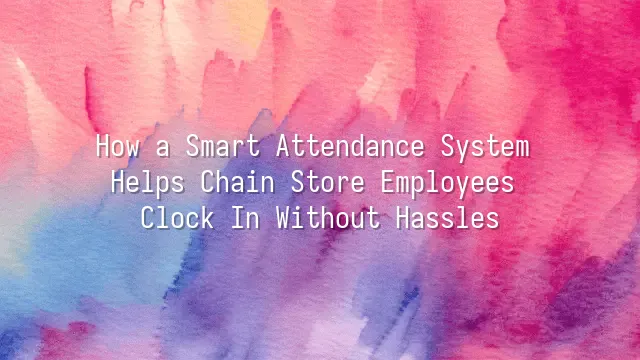
The Hidden Pitfalls of Chain Store Attendance Tracking: Who's Causing Daily Blasts?
The core challenge of a chain store employee DingTalk attendance tracking solution isn't about advanced technology, but rather the disconnect between policy and on-site reality. Many companies continue to face disputes after implementing digital attendance systems, primarily due to chaotic scheduling, undocumented staff transfers, and blocked appeal channels. Especially in hardware-limited environments like department store counters or mobile stalls, traditional打卡 devices cannot be installed. Relying solely on mobile GPS positioning often leads to "being present but marked absent" due to signal drift. More seriously, judicial practice has clearly indicated that dismissing employees based solely on DingTalk location records lacks sufficient evidentiary strength. In a 2016 case heard by Shanghai Jing'an Court, a cultural company lost the lawsuit and paid over 20,000 yuan in compensation due to the absence of supplementary written confirmation procedures. This reminds us that even the most powerful chain store employee DingTalk attendance tracking solution, if lacking compliance design, can become a trigger for labor-management conflicts.
DingTalk Is More Than Just a Clock-In Tool: Full Technical Breakdown
The technical architecture behind the chain store employee DingTalk attendance tracking solution is far more complex than it appears. Beyond basic GPS positioning, the system supports QR code scanning, Wi-Fi hotspot identification, and—new in 2025—biometric recognition, effectively reducing proxy check-ins by 72%. In terms of data security, attendance data hosted on Alibaba Cloud uses AES-256 encryption, meeting bank-level protection standards. More importantly, DingTalk’s open platform API v2.3 integrates with over 1,200 ISVs, enabling seamless connectivity with HR systems like Jiandao Cloud and GaiaWorks, allowing integrated management of scheduling, attendance, and payroll. This means businesses can build a customized chain store employee DingTalk attendance tracking solution that fits their operational rhythm through modular integration—without starting from scratch—greatly enhancing deployment flexibility and cost efficiency.
Building Your Smart Attendance Network from Scratch
The key to a successful chain store employee DingTalk attendance tracking solution lies in establishing a three-tier anomaly handling mechanism: the first tier allows employees to immediately appeal missed punches via the app; the second tier requires store supervisors to review and correct daily records; the third tier involves final lock-in confirmation by the HR department, forming a complete and traceable approval chain. This process not only improves efficiency but also provides solid evidence for potential future labor disputes. Additionally, top-tier systems like GaiaWorks have demonstrated that over 200 configurable parameters allow complex attendance rules to be set up within five minutes, with anomalies triggering alerts in under five minutes. However, all technological advantages must be paired with clear announcements and employee training; otherwise, even the most sophisticated chain store employee DingTalk attendance tracking solution can become a managerial burden due to communication gaps.
Winning in Real-World Scenarios: Case Studies Unveiled
The legal risks of a chain store employee DingTalk attendance tracking solution cannot be ignored. The Shanghai case shows that using GPS data alone as grounds for absenteeism may lead to failed evidence presentation. Beijing Chaoyang Court further requires cross-verification of location data with biometric information. Shenzhen Intermediate Court points out that electronic attendance records secured via blockchain have a 92% acceptance rate—significantly higher than the 67% of standard cloud systems. On the flip side, in retail, over half of attendance anomalies stem from last-minute schedule changes, which automation alone cannot resolve. Shyft Analytics’ AI system can predict staffing gaps up to 72 hours in advance during promotional periods, enabling proactive adjustments. This reveals that truly efficient chain store employee DingTalk attendance tracking solutions must evolve from passive recording to active early warning—transforming attendance data into an operational decision-support tool.
The Future of Attendance: Integrated Scheduling and Check-In
The ultimate goal of a chain store employee DingTalk attendance tracking solution is to serve as a central nervous system linking workforce planning with on-site execution. Leading systems today can already use historical sales, foot traffic, and holiday data to automatically recommend optimized shift schedules via AI—with 87% accuracy—and instantly sync these to the check-in module, preventing absurd situations where employees are penalized for working according to outdated schedules. Meanwhile, advanced anomaly detection algorithms analyze thousands of data dimensions, reducing false alarms by 38%, while mobile push notifications enable management response within five minutes—improving response speed by 89%. This isn’t just surveillance upgrade; it’s transforming attendance from a cost center into an engine for talent optimization. The future of chain store employee DingTalk attendance tracking solutions won’t be a battleground between workers and bosses, but a collaborative platform for boosting efficiency together.
We dedicated to serving clients with professional DingTalk solutions. If you'd like to learn more about DingTalk platform applications, feel free to contact our online customer service or email at

 English
English
 اللغة العربية
اللغة العربية  Bahasa Indonesia
Bahasa Indonesia  Bahasa Melayu
Bahasa Melayu  ภาษาไทย
ภาษาไทย  Tiếng Việt
Tiếng Việt  简体中文
简体中文 